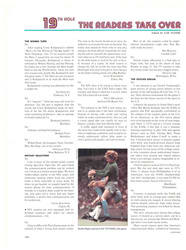
PAINTER FRANK STELLA APPLIES SOME FINE STROKES ON THE SQUASH COURT
Half a block from the bustle of Manhattan's lower Broadway there's a black wrought-iron door. Through the door, down some stairs, past a crumbling brick wall, along a narrow corridor topped with exposed pipes you'll find the master hard at work. His judgment is unimpaired by the glaring fluorescent lighting. The closeness of the room's four walls does not trammel the precision of his strokes. Sharp motions are embellished by delicate dabs. He works assiduously at his craft. Frank Stella, one of America's greatest painters, is playing squash.
Stella, 50, frequents the Park Place Squash Club. Although his paintings have made him wealthy, he favors the relative austerity of Park Place over the city's posher clubs because of its unpretentious, friendly aspect. Stella can slip in from his Greenwich Village studio, grab a root beer and chat about squash with the club's staff. Or he can lie down on a sofa in the lobby and catch a snooze. Mostly, though, he comes to Park Place to play. And when Stella plays, he does so as fervently as Jackson Pollock painted.
Renowned for his large, nonrepresentational canvases, Stella was the leading exponent of minimalist painting in the early '60s. He first achieved notice in 1959 for a series of black paintings with intervals of pinstripes. Stella has since experimented with Day-Glo colors, shaped canvases and geometrical abstractions. He has won considerable acclaim through exhibitions at such places as the Museum of Modern Art in New York City, the Los Angeles County Museum and Amsterdam's Stedelijk Museum.
Stella's squash also has the critics raving, though it took awhile. He was exposed to the game six years ago after he hurt his back while opening a garage door. As he had been an avid tennis player, squash, in which the serve does not require as much exertion, was recommended as an alternative. Intrigued, he took lessons, and kept at the game although, he says, "it made me claustrophobic at first. I still can't stand white floors. They make me dizzy." Soon he discovered Park Place with its homey atmosphere and natural wood floors.
His interest in the game has developed to such an extent that the reticent Stella has even taken an active role in promoting the sport. Last year when Park Place was host to the inaugural United States Professional Softball Squash championships, Stella designed the poster. This year he went a step farther and underwrote part of the $50,000 tournament, drummed up sponsors for it and, of course, designed the poster.
From May 30 through June 2, the best international players were pitted against the top North Americans. It was the first time such a strong field had played in the U.S. The finest player in the world, Pakistan's Jahangir Khan, who hasn't lost a softball tournament match since the finals of the British Open in 1980, defeated Ross Norman of New Zealand in the final. Lisa Opie of England beat Scotland's Heather Wallace for the women's title.
Park Place was the site of the tournament because it has one of the only 10 or so English, or softball, courts in America (there are about 3,400 hardball courts in the U.S.). The rest of the squash-playing world prefers softball to hardball, which is popular only in North America. Stella thinks softball—which uses a squishy ball, is played on a 21-foot-wide court and requires excellent conditioning—is the better game because it's easier to learn. He hopes that bringing the world's best softballers to the U.S. will popularize both the game and the sport in general. Squash is perceived by most Americans as a bastion of exclusivity, which Stella thinks is a shame. "Squash is a hard game, but a great city sport," he says. "It could be made less expensive." He hopes someday there will be public squash courts available to everyone.
Stella's skills are developing faster than his sport. Sammy Martinez, 18, a top junior player, says, "Stella can get on the court with anybody. He's the coolest' man on the court. He's got every shot figured out, and he can execute 95 percent of them. Give him a pair of 18-year-old legs and he's unbeatable." Stella hits hard, and beats younger, faster opponents by exploiting their deficiencies. He is officially a D (or intermediate) level player but he says, "I'm striving for C; I don't think I'll make it in my lifetime."
Perhaps, but not for lack of trying. Stella's friend Sam Posey, the former race car driver and current ABC racing commentator, says, "He's the most competitive person I've ever met, including all those Indy race car drivers."
Athletics serve as a diversion from the creative tensions of painting. Says Stella, "The advantage of squash is that I can forget about painting. A white blank and a ball; you don't know where you are. It's like a snowstorm." Indeed he compares the squash court to "a big, blank canvas," but says, "it's more fun than a canvas. When you get depressed you can go out there and run around." Nonetheless, Stella does see a relationship between his two passions: "There is something satisfying about the flow of movement, about constantly keeping the squash ball humming. Similarly, when things are flowing, you know you are painting well. When you feel awkward, things go badly. You do well when things flow as a whole."
Stella thinks there's a limit to the relationship between the two, however. "I'm not tempted to paint squash scenes," he says. "All squash has tempted me to do is break my racket."
PHOTO
GIORGIO PALMISANO
At Park Place, squash is raised to a high art by Stella (in red) and sculptor Stan Smokler.
PHOTO
GIORGIO PALMISANO
Stella's new work starts with paper models.

